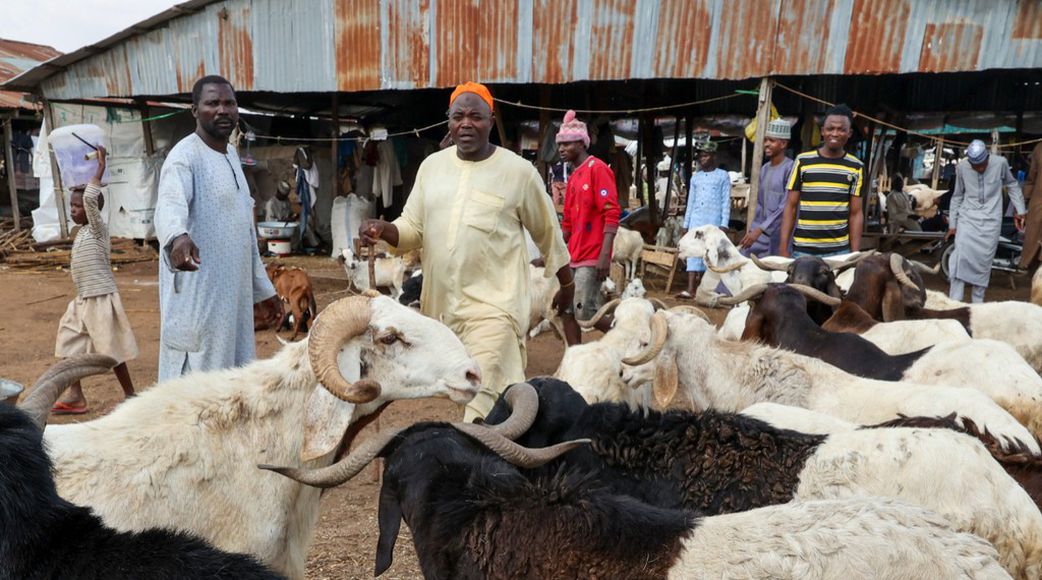
WafricNews — June 3, 2025
As Muslims across Nigeria prepare for Eid al-Adha, what should be a season of sacrifice and celebration is fast becoming a pocket-draining ritual, with ram prices hitting historic highs in major cities.
From Lagos to Kano, what was once a spiritual obligation is now being weighed against soaring inflation and a faltering naira. In many livestock markets, rams are no longer just animals — they’ve become economic indicators.
At several top markets surveyed by WafricNews, the price of a single ram has climbed as high as ₦1.2 million, depending on size and breed. But with the naira in freefall and cross-border livestock supply from Niger and Chad shrinking, traders and buyers alike are feeling the squeeze.
Ram Markets Now Reflect Nigeria’s Economic Pain
In Kano, where livestock trading is a tradition, even seasoned traders are noticing the tension. At Kabuga Livestock Market, Malam Nura Abubakar told WafricNews that prices may appear inflated, but it's the naira that’s weaker — not the rams more expensive.
“We’ve sold some rams for ₦1.2 million. Medium-sized ones now go for ₦550,000 to ₦700,000. Even smaller rams don’t go for less than ₦150,000,” he said.
For budget-conscious buyers, Madobi LGA just outside Kano offers some relief. Here, big rams range from ₦650,000 to ₦700,000, and smaller sizes start at ₦120,000.
Niger State Sees Mixed Pricing Trends
In Niger State’s Tunga Market (Chanchaga LGA), prices have remained fairly stable, with medium-sized rams selling for around ₦170,000 to ₦180,000. Larger rams start at ₦250,000.
But in Shiroro LGA’s Kuta Market, prices have shot up. “Last week, a ram that was ₦200,000 is now ₦300,000,” said buyer Haruna Bin-Suleiman, citing reduced imports from Niger and Chad as a major cause.
Abuja Offers Relative Price Stability
In the FCT, Karamajiji Ram Market—just a few kilometres from the city gate—has maintained more predictable prices. Rams go for between ₦150,000 and ₦350,000.
“There hasn’t been much fluctuation here,” said Saddam, a local market guide. “Prices have held steady for a few weeks, unlike in other parts of the country.”
In Lagos, Rams Break the Bank
In Lagos, Nigeria’s commercial nerve centre, the story is different. At Alaba Rago in Ojo LGA, smaller rams cost between ₦300,000 and ₦350,000, while larger ones can fetch up to ₦1 million.
Even in upper-middle-income neighbourhoods like Gbagada, prices aren't far off: medium-sized rams now start from ₦450,000, with smaller ones around ₦350,000.
And in Alagutan Market (Alimosho LGA), prices are even steeper. Trader Wakeel blamed insecurity in the North and a difficult economic climate. “It’s not our fault. Our suppliers up North are facing hardship. That’s what’s pushing prices up.”
However, in Agege, a more moderate pricing trend has emerged. Trader Lamiyyu Ungongo explained that poor sales have forced traders to keep prices from spiralling. “People aren’t buying as they used to, so we’re trying to keep things reasonable.”
The Real Cost of Celebration
What this pricing surge reveals is deeper than just festive demand. The Nigerian livestock sector is now caught between weak currency value, broken trade routes, and insufficient domestic production.
From farmers in the North to market stalls in the South, the ripple effects are clear. As imports dwindle and transport costs spike, local markets are under pressure — and consumers are footing the bill.
According to WafricNews analysts, unless Nigeria strengthens its livestock value chain, improves food transport infrastructure, and stabilizes the naira, festive periods like Eid will continue to bring financial strain instead of joy.
For now, families must balance their faith with their finances — and look a little harder for those better-priced rams.
By WafricNews Desk.


)
)
Comment
To post a comment, you have to login first
LoginNo Comments Yet...